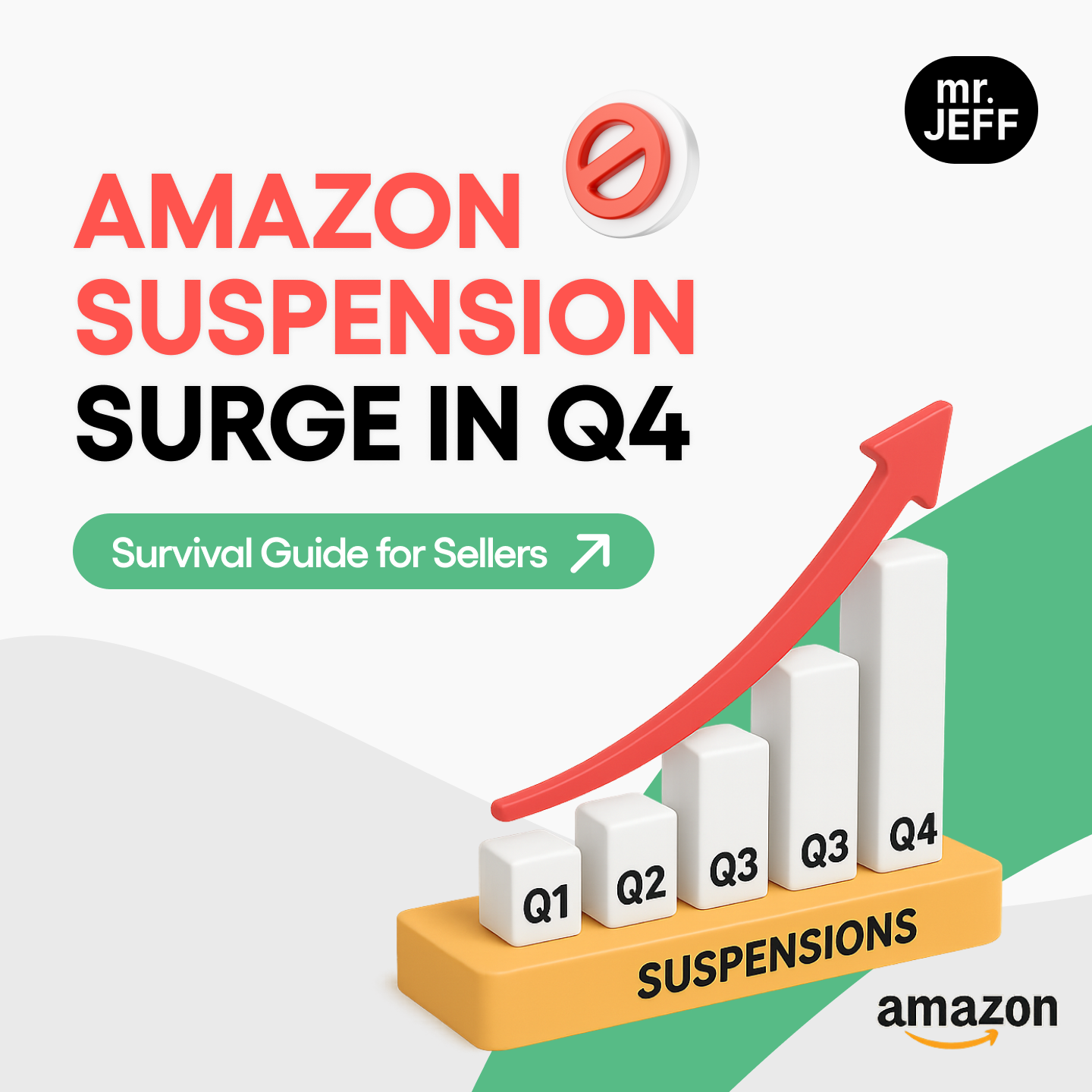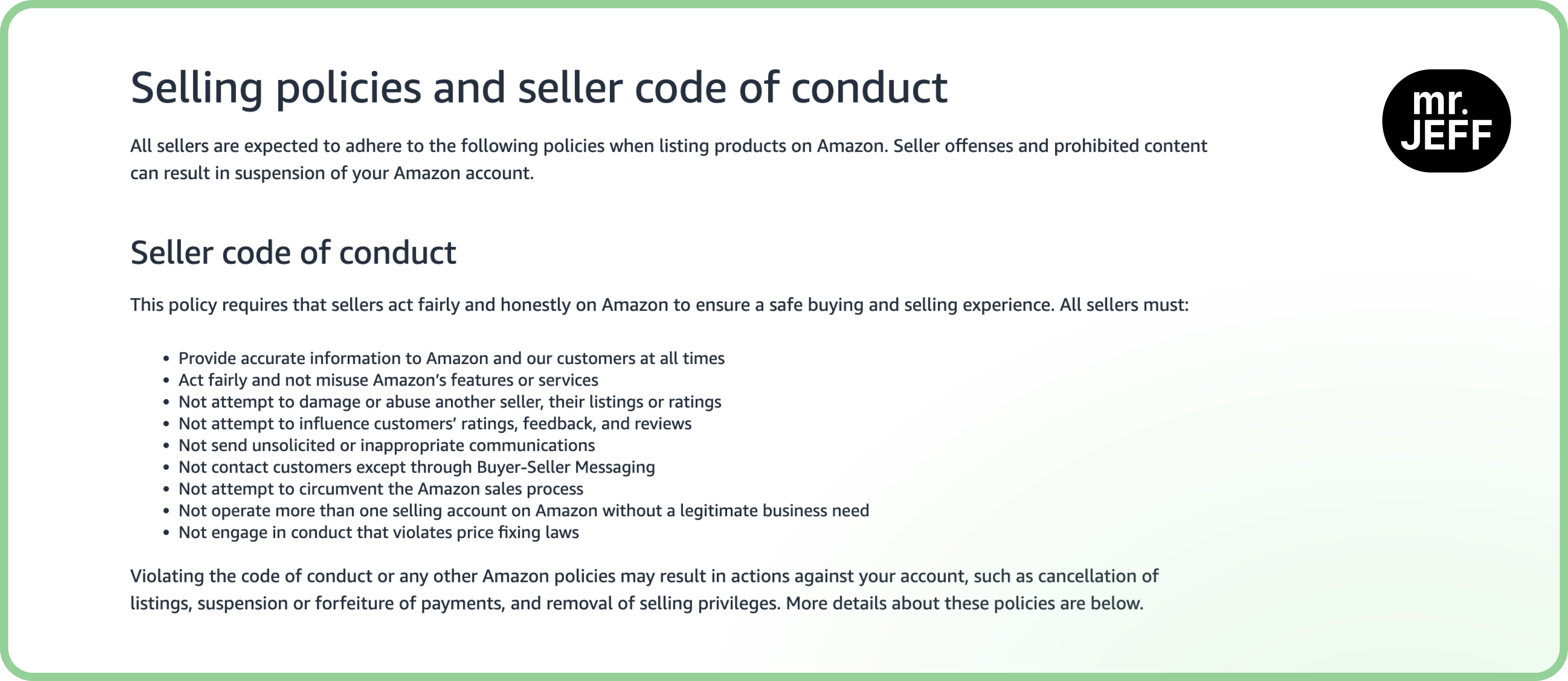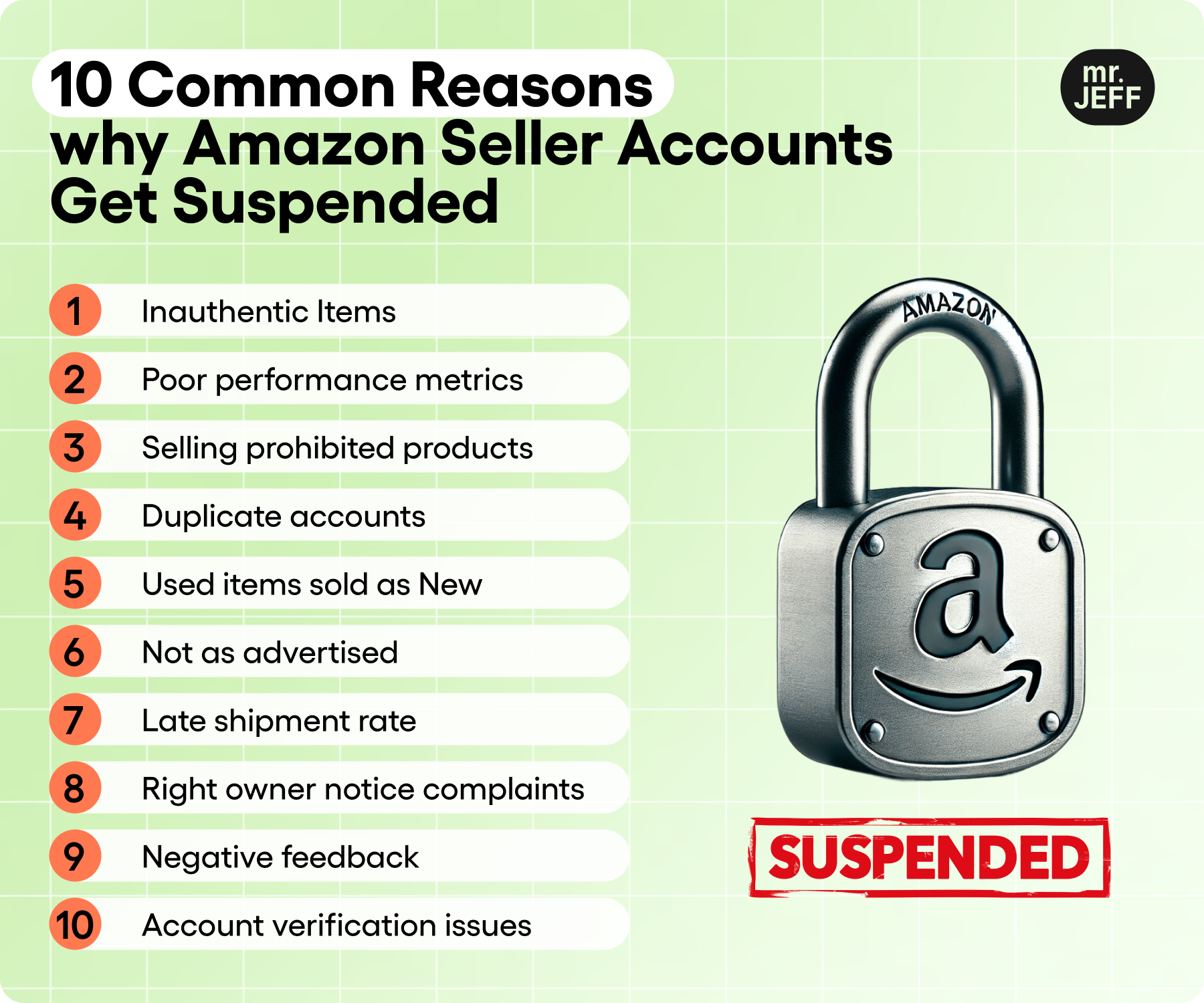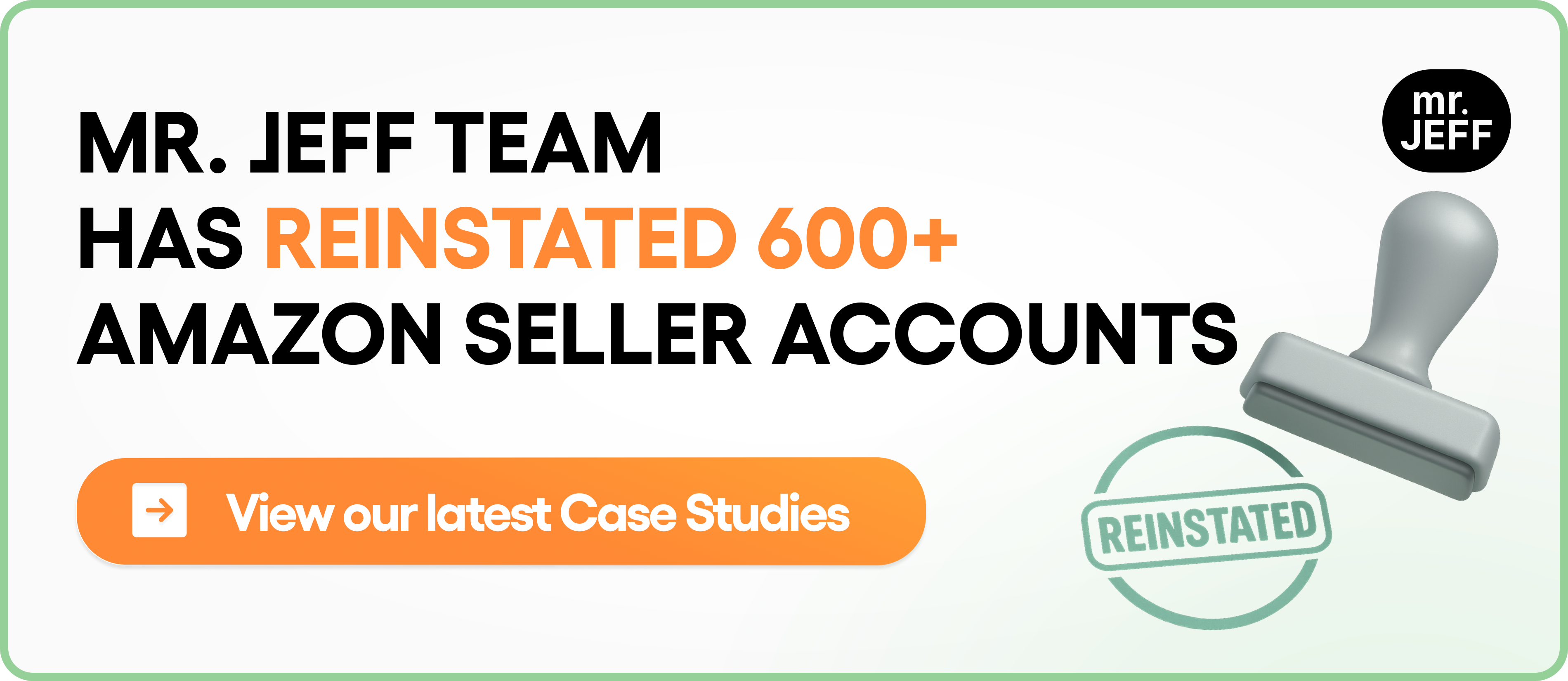
Every Amazon seller dreams of a record-breaking Q4. It’s the period when advertising clicks convert, inventory turns faster, and revenue peaks. But at Mr. Jeff, we’ve seen the other side of this story too many times — sellers getting their accounts suspended right before the holidays.
During Q4, Amazon tightens its compliance systems to protect customers and ensure order reliability. Unfortunately, that also means thousands of legitimate sellers face unexpected deactivations due to stricter algorithms, invoice reviews, or minor policy inconsistencies.In 2025, with Amazon tightening enforcement around authenticity, supply chain documentation, and account integrity, the risk is even higher.
In 2025, Amazon’s focus on authenticity, supply chain documentation, and account integrity has made the rules tougher than ever. The result? Even experienced sellers can find themselves suspended overnight.
A single suspension in November or December can wipe out your most profitable weeks of the year. The key is not luck — it’s preparation. You need to know exactly how to protect your account and how to act fast if the suspension happens.
Expert Insight:
“Every Q4, we see a 30–40% increase in suspension cases. Most of them were preventable with simple pre-season checks.” – Rick, Amazon Reinstatement Expert at Mr. Jeff
In this article, we’ll cover everything you need to stay safe this season:
Every year, Q4 turns Amazon into the most competitive and most volatile sales environment. Sellers double their ad spend, launch new products, and move inventory faster than at any other time. But what many forget is that Amazon’s compliance systems also shift into overdrive.
At Mr. Jeff, we see this pattern repeat every holiday season: as sales rise, so do suspension cases. And not because sellers suddenly start breaking the rules — but because Amazon’s automated systems become far less forgiving.
Here’s why the risk climbs so sharply in Q4:
The takeaway?
Q4 isn’t the time to “hope for the best.” It’s the time to audit, double-check, and document everything — from invoices and supplier credentials to product listings and account health metrics.
Amazon rarely suspends accounts without prior signals. The problem is — most sellers overlook them.
At Mr. Jeff, we’ve learned that acting on early warnings often prevents full deactivation altogether.
Here are the red flags you should never ignore before Q4:
Expert advice from Mr. Jeff:
Check your Account Health Dashboard daily during Q4. Treat every warning as urgent — even if it seems minor. The faster you act, the higher your chances of avoiding a full suspension.

Amazon’s policies evolve every year — and 2025 has brought one of the strictest compliance updates we’ve seen so far. While these changes are designed to increase buyer trust, they also create new risks for honest sellers who aren’t aware of the details.
Let’s break down what’s changed and how it could affect your account this Q4:
Amazon now requires deeper transparency into your supply chain.
If your invoices or supplier details cannot be verified through legitimate business channels, your listings can be flagged as “potentially inauthentic” — even if the products are 100% genuine.
What this means for you:
Even one unverifiable invoice can trigger a temporary deactivation.
Amazon’s AI now analyzes device fingerprints, IP addresses, browser sessions, and even behavioral patterns across accounts.
This means that sellers who share resources — like virtual assistants, accountants, or software tools are at higher risk of being flagged for “related accounts.”
Stay protected by:
At Mr. Jeff, we’ve handled numerous reinstatements where sellers had no idea their accounts were “linked.” It only takes one shared login or Wi-Fi session to connect two businesses in Amazon’s system.
Amazon’s automated review teams are now cross-checking invoice details against catalog data, brand registries, and even supplier contact info.
If anything looks inconsistent — product name, SKU, quantity, or address — you may receive a sudden authenticity claim.
How to stay compliant:
These audits often happen in Q4, when order volumes spike and counterfeit complaints rise.
One of the biggest 2025 updates is Amazon’s renewed focus on its Fair Pricing Policy.
The platform now automatically compares your product prices to other marketplaces and competitor listings. If the system detects that your prices are significantly higher — even due to shipping costs or regional differences — it may flag your listing for price manipulation or price gouging.
How to avoid pricing-related suspensions:
Fair pricing enforcement in 2025 is automated, fast, and unforgiving — even experienced, compliant sellers can be caught by algorithmic comparisons.
Amazon also adjusted FBA policies in 2025:
These changes make operational efficiency more important than ever.
Any inconsistency between sales volume, refunds, or shipment rates can activate account health warnings.
Amazon suspensions don’t target one specific type of seller — but every year, we see the same patterns repeat.
Certain business models are naturally more exposed to compliance risks, especially during Q4 when Amazon’s systems become more sensitive.
At Mr. Jeff, our reinstatement specialists analyzed hundreds of cases from the last two Q4 seasons. The results are clear: sellers who fall into the categories below face the highest risk of sudden deactivation.
Resellers who purchase from non-authorized distributors or local wholesalers are under heavy scrutiny. Amazon’s authenticity algorithms are becoming more aggressive, automatically checking whether supplier details can be verified online.
Tip: Work only with brand-authorized suppliers and keep invoices clear and verifiable.
New Amazon accounts, especially those less than one year old — often lack the reputation data Amazon uses to assess trust. A sudden spike in sales volume, incomplete business verification, or inconsistent documentation can trigger temporary suspension.
Tip: Grow gradually, maintain perfect documentation, and respond fast to any verification requests.
Health, beauty, supplements, and personal care sellers face the toughest compliance standards in 2025. Missing Certificates of Analysis (COAs), inaccurate labeling, or unsubstantiated health claims can all lead to account suspension.
Tip: Keep certificates updated and remove risky health claims before Q4.
Q4 brings massive order spikes — and with them, the smallest performance issue can escalate quickly. Late shipments, high return rates, or FBA stockouts may trigger warnings or automatic deactivations.
Tip: Maintain 45+ days of FBA stock and monitor Account Health daily.
With Amazon’s Fair Pricing policy now automated, sudden price jumps can flag your listings.
Tip: Keep pricing consistent across channels and document any legitimate cost changes.
Sellers who maintain consistent documentation, clean account behavior, and transparent pricing rarely face sudden suspensions.

Preparation is your strongest defense. At Mr. Jeff, we always remind sellers — you can’t control Amazon’s algorithms, but you can control how clean and compliant your account looks when Q4 pressure hits.
Before the holiday rush, complete this short but powerful checklist to protect your business:
When Q4 traffic spikes, a quick, organized response can save your account.
Have ready:

Even well-prepared sellers can face suspension during Q4. What separates those who recover quickly is how they respond in the first 24 hours. At Mr. Jeff, we treat every suspension like an emergency — because in Q4, every day offline costs you money.
Read Amazon’s notification carefully. Identify the exact reason: policy violation, authenticity concern, linked account, or performance issue.
Never send multiple appeals blindly — it weakens your case.
Collect all relevant documents: invoices, LOAs, COAs, supplier contacts, and performance screenshots.
Amazon wants facts, not emotions — make sure your data supports your story.
Your POA should explain:
Keep it short, structured, and focused on evidence — not excuses.
Use the official appeal channel. Attach only what’s relevant and wait for Amazon’s reply before resubmitting. If rejected, revise carefully — don’t resend the same version.
If your appeal stalls, request a supervisor review.
When handled correctly, second-tier escalations often succeed. At Mr. Jeff, we’ve reinstated hundreds of accounts this way — even tough Section 3 and Linked Account cases.
Every suspension has a solution — if handled correctly.
At Mr. Jeff, we’ve successfully reinstated hundreds of accounts by combining deep Amazon expertise with strategic communication.
Here are a few real reinstatement cases handled by our team:
A seller was suspended for violating Amazon’s dropshipping policy after unknowingly using a third-party fulfillment method.
This seller was flagged for selling “inauthentic” items despite sourcing from legitimate distributors.
Two sellers operating under separate entities were deactivated due to a shared registered address.
A private label brand faced dual suspensions across UK and US marketplaces after system cross-linking.

For over five years, the team at Mr. Jeff has been protecting Amazon sellers through our Amazon Account Reinstatement Service, helping them get reinstated quickly, safely, and without unnecessary stress.
When every day of suspension means lost revenue, you need experts who understand Amazon’s systems — and know exactly how to navigate them from the inside out.
Your Amazon business deserves expert protection.
Fill out the form on our website, share the details of your case, and our team will review it within hours to provide clear next steps toward reinstatement.
.png)

Join our Referral Program and start earning money with Mr. Jeff!
Recommend us and get $50 for each client who purchases any of our products.
Amazon seller can use your referral code to get 10% OFF our services.